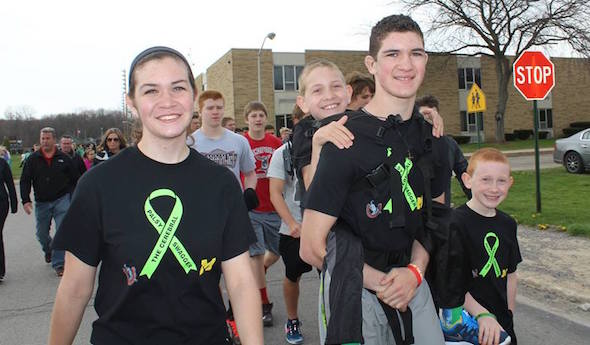
Bedford's Gandee Honored for 'Spirit'
March 13, 2017
By John Gillis
Special from NFHS
Hunter Gandee, a student-athlete at Temperance Bedford High School, has been selected as the 2017 Section 4 recipient of the “National High School Spirit of Sport Award” by the National Federation of State High School Associations (NFHS).
The National High School Spirit of Sport Award was created by the NFHS to recognize those individuals who exemplify the ideals of the spirit of sport that represent the core mission of education-based athletics.
The mark of a “good big brother” is often to what lengths he might go to assist his younger siblings.
That sense of familial assistance has perhaps never been taken to the extremes that Hunter Gandee has repeatedly done for his younger brother Braden.
A standout student, Hunter is a junior with a 3.92 grade-point average and a member of the National Honor Society.
On the sports side, Hunter is in his third season on the varsity wrestling team, and participates in Greco-Roman and freestyle wrestling during the offseason. He's also a member of the MHSAA Student Advisory Council.
While those accomplishments are unquestionably outstanding, they might pale in comparison to what he has done for Braden.
Born with cerebral palsy, Braden has limited use of his legs. Nonetheless, Hunter has taken it upon himself to help Braden know what it feels like to walk long distances – and he’s done it three times. Organized for the purpose of raising awareness of cerebral palsy, Hunter literally carries Braden on his back for long walks known as “CP Swaggers.”
In 2014, Hunter carried Braden 40 miles from the Bedford Junior High School wrestling room to the University of Michigan’s Bahna Wrestling Center. The following year, they upped the trek’s mileage to 57 miles.
However, that couldn’t foreshadow what was to follow in April 2016 when Hunter carried Braden on his back an amazing 111 miles – some 14 miles more than the first two walks combined.
About the Award: The NFHS divides the nation into eight geographical sections. The states in Section 4 are Michigan, Illinois, Indiana, Iowa and Wisconsin.
Nominations for this award were generated through NFHS member state associations and reviewed by the NFHS Spirit of Sport Award Selection Committee composed of state association staff members.
While the national winner will be recognized June 29 at the NFHS Summer Meeting in Providence, Rhode Island, the section winners will be recognized within their respective states and will receive awards before the end of the current school year.
PHOTO: Hunter Gandee, second from right, carries his brother Braden as part of their effort to bring awareness to cerebral palsy. (Photo courtesy of The Cerebral Palsy Swagger.)

Council Approves Winter Start, Guidance
October 23, 2020
By Geoff Kimmerly
Second Half editor
The Representative Council of the Michigan High School Athletic Association confirmed during its meeting Thursday (Oct. 22) that 2020-21 Winter sports will begin on time, and also approved a series of guidelines for those sports that schools must follow as they continue to work toward limiting the spread of COVID-19 while still providing opportunities for athletes to compete.
Most high school sports traditionally begin practice during the first three weeks of November, with competition starting during mid-November and the first weeks of December. The starts of middle school Winter sports seasons are determined by local leagues and conferences; many are slated to begin during the next few weeks.
Sport-specific guidelines for all Winter sports will be posted early next week to their respective sport pages on the MHSAA Website. A number of precautions have been put in place addressing competition limits, numbers of spectators allowed and wearing of face coverings, among a variety of topics. The guidance also specifically addresses equipment and facilities for each sport.
“The Council believes it is safer to begin Winter practices on time, and keep athletes in school programs where safety precautions are always in effect,” MHSAA Executive Director Mark Uyl said. “With the vastly different circumstances faced by schools in different regions all over the state, an on-time start still allows schools to decide when they feel most comfortable beginning activity – and allows all of them to slowly ramp up their frequency of activity and numbers of spectators attending competitions.
“But let’s be clear: Our statewide COVID-19 numbers have to get better. In order for our schools to continue playing sports this winter, and in order for fans to be there to cheer them on, we must continue working to slow down this virus.”
As with Fall sports, scrimmages will not be allowed for Winter sports to limit mixing of communities outside of official competitions. The numbers of teams at regular-season competitions also will be limited, like during Fall, with a maximum of four schools/teams allowed in competitive cheer, gymnastics, swimming & diving and wrestling. Bowling and skiing competitions will be restricted to a maximum of 72 competitors at one event.
There are no school/team limits for basketball and ice hockey, as only two teams are able to play each other at one time and those sports may play only one game per day – with fans leaving after their game is complete. Host sites must strictly enforce spectator capacity limits on a game-by-game basis. The Council approved as part of these guidelines an allowance of two spectators per participant at all contests to begin the regular season. This guideline could be reconsidered by the Council later in the winter season, with a possibility of allowing more spectators later while still staying within possible Emergency Orders from the Michigan Department of Health and Human Services (MDHHS).
As per MDHHS requirements, face coverings must be worn by athletes practicing and competing in basketball, competitive cheer, ice hockey and wrestling. They are not required for athletes practicing and competing in bowling, gymnastics, skiing and swimming & diving, which all allow for appropriate social distancing – but face coverings are required for those athletes when not involved in active participation.

